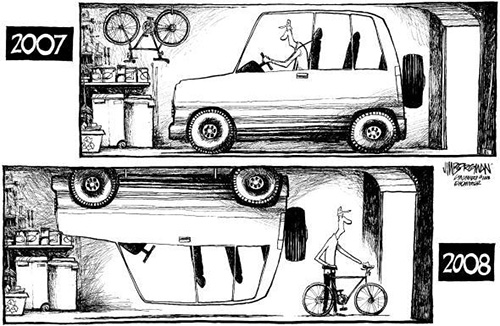Bikes or cars — who rules the road?
By Alex Johnson - MSNBC
Over the last two months, Taylor Cabaniss’ morning commute has evolved into something entirely new. It has lengthened to an hour.
But that’s a good thing, said Cabaniss, a senior financial manager for Qualcomm Inc. in San Diego — it’s “just some good exercise opportunity, to get out a bit.”
Back in May, Cabaniss abandoned his car and began biking to work. With fuel prices topping $4 a gallon, it makes a big difference.
“I’m probably saving a gallon and a half a day — I imagine $6 a day,” he said.
Cabaniss’ story is a common one. Since the average price of gasoline hit about $3.25 a gallon early this year, bike sales have skyrocketed, the National Bicycle Dealers Association reported. Store owners across the country say two-wheelers are flying out the door faster than they can stock them.
“Gas prices have jacked our business quite a bit,” said Jamie McDonald, owner of Sunrise Cyclery in Minneapolis. “I’ve sold way more racks, way more bags, way more lights, way more fenders and more bikes in general than I ever have before.”
At Wheel Nuts in Alexandria, Va., a suburb of Washington, owner Ron Taylor sounds a common theme — he’s having trouble keeping up with both sales and repairs.
“With all of that business coming in, we’ve actually had to hire additional staff,” Taylor said. “We’re staying here late, trying to meet customers’ demands, trying to get their bikes back to them sooner.”
More bikes mean more accidents
Experts welcome the trend for all of the reasons you might expect: Transportation planners like that fewer cars clog the nation’s highways. Environmental activists like that fewer tons of greenhouse emissions are pumped into the atmosphere every rush hour. Doctors like to see more people pedaling off more pounds.
But in the months since motorists began pedaling in droves, it has become clear that all those cyclists on the streets pose a significant problem: all those cyclists on the streets.
“I believe it’s definitely going to cause some problems, because people don’t know how to share the road with cyclists,” said Kirk Hendricks, director of advocacy for the group Idaho Cycling Enthusiasts. “[Drivers] need to know that we have as much right as an automobile even though we’re not as big.”
There are no nationwide statistics on bicycle-related injuries and deaths for the first half of 2008. But authorities across the country say they are seeing a sharp rise in the number of accidents involving bicyclists.
“Last year in New Jersey 12 bikers, bicyclists, were killed in motor vehicle crashes,” said Pam Fischer, director of the state Division of Highway Traffic Safety. “So far this year — and we’re at the middle of the summer, July 15 — we have already lost 11 bicyclists.”
Fischer said that “in almost every case, the bicycle was doing something that put them at significant risk.”
At least five bicyclists have been killed in Chicago alone this year, leading to lawsuits, organized protests demanding safer bike routes and a set of new ordinances requiring drivers to give cyclists at least a 3-foot-wide berth when passing.
“Most of the crashes that we’ve seen are a result of inattentive driving,” said Rob Sadowsky, executive director of the Chicagoland Bicycle Federation.
